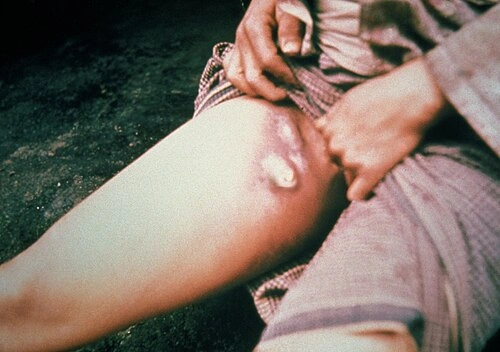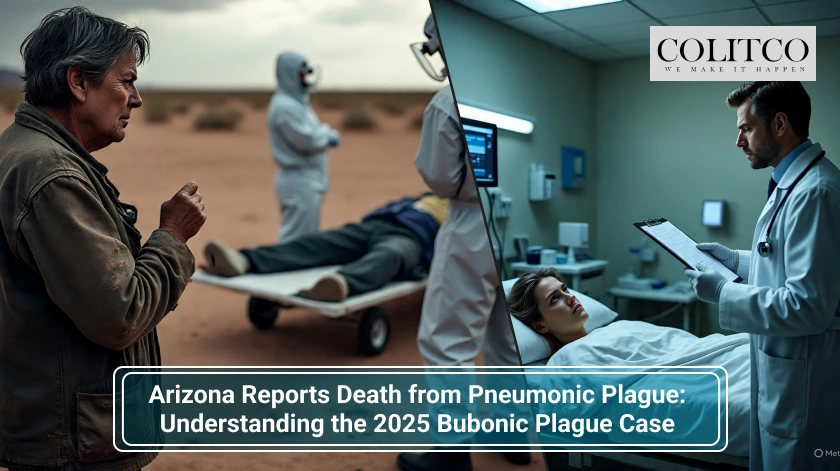Fatal Plague Case in Flagstaff, Arizona
[Warning: Contains Sensitive Images]
Health authorities in Arizona have confirmed that a resident of Coconino County died from pneumonic plague after being treated at the Flagstaff Medical Center’s emergency department. The patient died on the same day they arrived at the hospital, according to Northern Arizona Healthcare.
The hospital stated that it provided “appropriate initial management” and made “attempts to provide life-saving resuscitation,” but the patient could not be revived. Coconino County Health and Human Services (CCHHS) later confirmed the cause of death as pneumonic plague, a severe lung infection caused by the Yersinia pestis bacterium.
This marks the first recorded death from pneumonic plague in Coconino County since 2007, when a person came into contact with a dead animal infected with the disease.

Bubonic Plague 2025: Background on the Disease
The plague is an infectious disease caused by Yersinia pestis. It manifests in three main forms: bubonic, pneumonic and septicemic. The bubonic plague, which wiped out millions during the Black Death in 14th-century Europe, remains the most widely known form.
While the plague is often thought of as a relic of the past, the bacterium still circulates in some parts of the world. Cases of bubonic plague are reported in the United States every year, particularly in the rural west. Globally, plague exists in animals on every continent except Oceania, with human outbreaks most commonly occurring in the Democratic Republic of Congo, Madagascar, and Peru.
Bubonic vs Pneumonic Plague: What’s the Difference?
Bubonic plague infects the lymph nodes and presents with painful swellings or “buboes” in the armpits, groin or neck. Pneumonic plague, on the other hand, targets the lungs and can develop either from untreated bubonic or septicemic plague or from direct inhalation of infectious droplets.
According to the Centres for Disease Control and Prevention (CDC), pneumonic plague is the only form of the plague that can spread from person to person via airborne droplets. However, there have been no documented cases of person-to-person transmission in the United States since 1924. It is more likely to spread through contact with sick animals.
The World Health Organization (WHO) warns that pneumonic plague is the deadliest form of the disease and is always fatal if untreated. In contrast, bubonic plague has a fatality rate between 30% and 60% if not treated promptly.
Plague in Arizona: Is it Common?
Although rare, plague in Arizona is not unprecedented. The CDC reports an average of seven human plague cases annually across the United States, typically in rural areas of northern Arizona, northern New Mexico, southern Colorado, California, and parts of Oregon and Nevada.
This latest case of bubonic plague in Arizona has raised concerns, especially following a recent prairie dog die-off reported in the Townsend Winona area northeast of Flagstaff. The CCHHS stated that such die-offs often signal the presence of the plague. However, they clarified that the recent human fatality is unrelated to the prairie dog incident.
CCHHS has since partnered with private landowners to test fleas from the affected area and treat burrows to control flea activity.
How the Plague Spreads and Shows Symptoms
Humans typically contract bubonic plague through flea bites or by handling infected animals, including household pets like dogs and cats. Early symptoms of bubonic plague include fever, chills, and painful, swollen lymph nodes. Pneumonic plague symptoms include fever, chest pain, difficulty breathing, bloody or watery mucus, and cough.
Septicemic plague, the third type, may cause chills, abdominal pain, internal bleeding, and blackening of the skin and tissue. All forms of the disease require rapid medical intervention.
Prevention, Treatment, and Public Health Response
There is currently no vaccine for the plague available in the United States. However, modern antibiotics can effectively cure the disease if administered early. According to the WHO, the incubation period for pneumonic plague can be as short as 24 hours, while bubonic plague typically appears within two to eight days.
“Pneumonic plague can be fatal within 18 to 24 hours of disease onset if left untreated,” the WHO has warned.
Health officials recommend preventative measures such as applying insect repellent, using flea control on pets, wearing gloves when handling animals, and rodent-proofing homes.
Also Read: Understanding Lyssavirus: Rare Bat-Borne Disease Claims Fourth Life in Australia
The Flagstaff Medical Center is collaborating with CCHHS and the Arizona Department of Health Services to investigate the recent bubonic plague Arizona case. They urged anyone experiencing symptoms of a contagious disease to contact a healthcare provider immediately or request a mask upon entering an emergency department to prevent further spread.
Coconino County Board of Supervisors Chair Patrice Horstman extended condolences to the victim’s family, stating, “Our hearts go out to the family and friends of the deceased. We are keeping them in our thoughts during this difficult time.”
FAQs: Bubonic Plague 2025 and Pneumonic Plague in Arizona
What is bubonic plague?
Bubonic plague is an infectious disease caused by Yersinia pestis. It primarily infects the lymph nodes, resulting in painful swellings or “buboes.” It was responsible for the Black Death in the 14th century.
What is pneumonic plague?
Pneumonic plague is a severe lung infection caused by Yersinia pestis. It can develop from untreated bubonic or septicemic plague or spread through airborne droplets. It is the deadliest form of the plague if left untreated.
How common is the bubonic plague in 2025?
Bubonic plague 2025 remains rare. In the United States, around seven human cases occur annually, with most reported in the rural western regions, including Arizona.
Is the recent plague in Arizona linked to animal deaths?
Health officials reported a prairie dog die-off near Flagstaff as a possible plague indicator. However, they confirmed that the recent human death is not linked to that incident.
How is the plague treated?
Antibiotics effectively treat all forms of the plague if given early. There is no vaccine currently approved for use in the United States.
What are the symptoms of bubonic plague and pneumonic plague?
Bubonic plague causes fever and swollen lymph nodes. Pneumonic plague leads to fever, chest pain, breathing difficulties, and cough. Both require immediate medical attention.
How does the plague spread?
Bubonic plague spreads via flea bites or contact with infected animals. Pneumonic plague can spread through airborne droplets, though this is extremely rare in the U.S.
What should I do if I suspect I have the plague?
Seek medical help immediately. If your symptoms are severe, go to the emergency department and request a mask to reduce the risk of spreading disease.












